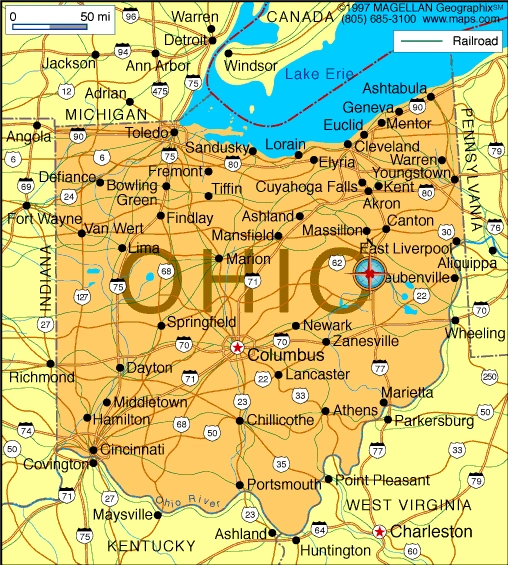Columbus (Ohio) - geography.
Publié le 04/05/2013
Extrait du document


«
A balance among manufacturing, technology, research, and financial activities has helped Columbus’s economy to continue to boom.
Much of the city’s expansion resultsfrom its function as a sophisticated service center.
By 1990 manufacturing occupied only 12 percent of the area’s labor force.
That contrasted with services, includinggovernment, finance, and transportation and utilities, which accounted for almost 60 percent of all employment.
The two largest employers in Columbus are state government and The Ohio State University, with well over 20,000 employees each.
Other important employers areHonda of America, Nationwide Insurance, AT&T, and Anheuser-Busch.
Smaller in size are companies with national headquarters in the city such as American ElectricPower (electricity generation), The Limited (retail clothing), and Wendy’s International (fast-food outlets).
Battelle Memorial Institute, which conducts research forprivate industry and government, has its world headquarters in Columbus.
Leading information providers making their home in Columbus are the Online ComputerLibrary Center (OCLC), a pioneer bibliographic and information network; Chemical Abstracts Service, a division of the American Chemical Society, producing the world’slargest databases of chemical information; and CompuServe, offering a spectrum of online and network services for businesses and individuals.
Columbus lies along Interstate 70, a major east-west route following the route blazed by the National Road.
Interstate 71 connects Columbus with both Cleveland andCincinnati.
The Port Columbus International Airport, located to the northeast of the city, was established in the 1920s as one of the major stops for earlytranscontinental flights.
Today the busy airport serves airlines flying to both domestic and international destinations.
Rickenbacker Airport, to the south of the city, is animportant facility for air cargo operations.
It was named for Eddie Rickenbacker, famed World War I pilot and business executive who was born in Columbus.
VII GOVERNMENT
The municipal government of Columbus consists of a mayor and seven city council members elected citywide to four-year terms.
The administrative branch is led by themayor.
The city council is the legislative authority for the city.
VIII HISTORY
In 1812 the Ohio State Legislature, after searching for a central location for the state capital, chose the present site of Columbus on the Scioto River oppositeFranklinton, a thriving trade center since 1797.
The legislators voted to name the community in honor of Christopher Columbus, and government offices were movedthere in 1816 from Chillicothe, Ohio’s first state capital.
With its population peacefully coexisting with the region’s Wyandot and Shawnee peoples, Columbus grewrapidly; in 1824 it absorbed Franklinton and became the seat of Franklin County.
The site of Columbus was not only centrally positioned, but it also offered an easy crossing point of the Scioto River.
The high east bank also provided a site safe from allbut the highest floods.
(The limits of that safety were reached in 1913 when record-breaking rains brought a devastating flood, considered the city’s worst disaster.)Stimulated by advantageous access to transportation, Columbus grew steadily throughout the 19th century.
The Ohio and Erie Canal passed close to the city and ashort feeder canal opened in 1831, connecting Columbus to both Lake Erie and the Ohio River.
In 1833 the National Road, a primary route used by settlers travelingwest, reached the city.
Railroads began to arrive in 1850, bearing the famous railway names of Baltimore and Ohio, Norfolk and Western, New York Central,Chesapeake and Ohio, and Pennsylvania.
The city, incorporated in 1834, reached a population of almost 20,000 by 1860.
The American Civil War (1861-1865) resulted in considerable military activity in Columbus.
Army camps and other installations were set up, the best known of which wasCamp Chase, the largest military prison for Confederate soldiers.
The foundations of manufacturing were laid in the second half of the 19th century.
Wagon and carriagemanufacture flourished, partly because of the strategic location of Columbus along major routes and partly due to the prosperity of Ohio agriculture and acorresponding need for farm wagons.
Food processing and the manufacture of shoes, mining machinery, castings, communications equipment, and fire engines formedthe basis of early industrialization.
The city is also important in labor history; the American Federation of Labor was founded in Columbus in 1886 during a period whenworkers were agitating for an eight-hour work day.
Columbus prospered in the second half of the 20th century, even as much of the rest of Ohio began to suffer industrial decline.
The city’s good fortune was largelybecause of the growth of state government, higher education, finance and insurance, and light industry.
This prosperity has given to Columbus an above averagestandard of living, a relatively crime free environment, and a general sense of well being.
Contributed By:Allen NobleMicrosoft ® Encarta ® 2009. © 1993-2008 Microsoft Corporation.
All rights reserved..
»
↓↓↓ APERÇU DU DOCUMENT ↓↓↓
Liens utiles
- Columbus (Ohio) - geography.
- Nicklaus Jack , né en 1940 à Columbus (Ohio), joueur de golf américain.
- Ohio - geography.
- Cleveland (Ohio) - geography.
- Cleveland (Ohio) - geography.

































